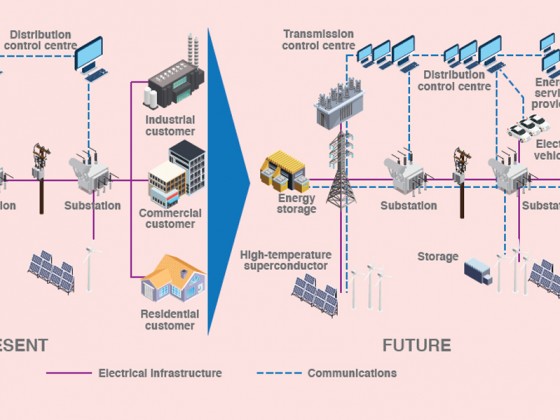by | Sri Widias Tuti Asnam Rajo Intan, sriwidias@might.org.my
Implementing Industry 4.0 amongst at the top of the priority list for most companies. At the moment however, Industry 4.0’s impact can only be significantly felt in manufacturing and the future of work. Despite this, the maritime industry is slowly picking up steam. The industry, which largely consists of shipping, ship building and repair companies and port authorities has slowly begun to take steps towards scaling a digital transformation.
Production efficiency, ship safety, cost efficiency, energy conservation and environmental protection in the maritime industry will pose unprecedented challenges as well as opportunities for the maritime industry. Maritime companies have a big role to play to take the industry forward. The impact of Industry 4.0 will be significant, causing enduring changes and disruptions throughout. The implementation of Industry 4.0’s brand new technologies and practices will create values never seen before in the process. And demand for new solutions will surge along with a pressing challenge to reduce production and operational costs. At the same time, production efficiency will also be increased.
Although Industry 4.0 is still in its nascency, its unintended or unforeseen consequences remain to be seen. Essentially, how do we make sure unintended consequences can be minimalised across the industry’s social and business aspects? In this article, we will explore in what ways, unintended consequences of Industry 4.0’s practices and technologies will shake up the maritime industry.
AI and Autonomous ship
The shipping industry is undergoing a massive global transformation and artificial intelligence (AI) has become a buzzword for one of the most happening trends in the industry. To put the development into perspective, AI is aiding an industry-wide shift by integrating new shipping logistics and communication technologies, evolving long-held traditional business models. Soon, autonomous ships cruising the sea are going to be a common sight and the main benefit of the sailor-less system is in taking out human errors to enhance safety at sea.
>> Impact :
- Data captured by the Marine Department of Malaysia shows a significant drop in the number of seafarer yearly registrations since 2013. But in 2019, the number increased again after tapering off a few years earlier. Why? Does this indicate that the shipping industry is bouncing back? Yet most ships will be autonomous in the near future. This raises one big question—where will these seafarers go?
- The common sentiment being shared in the industry is the perception that ports’ daily operation systems are unable to cope with rapid technology advancement. Infrastructure growth is limited and a massive amount of investment is urgently needed to keep pace with the latest trends showing up. Coordination between ports and other players in the network chain is also a concern. Documentary requirements and procedures on the arrival, are still using manual systems across port operations. Moving forward, this needs to change dramatically to support smart port operations. Additionally, various skill gaps must be addressed as some traditional shipping jobs will no longer be relevant.

3-D Printing Technology
Commercial ship operators may benefit from the emergence of cost-effective and reliable 3D printing. The technology will reduce inventory of spare parts stored on board and can be particularly helpful in the case of difficult-to-source components.
The parts can also be produced without the heavy scantlings previously created through the casting process with efficient lightweight options. Small basic parts such as valves, pipes or impellers could potentially be made on board in the event of a failure.
>> Impact :
- The cost and availability of 3D printing materials may turn out to be the main obstacles hindering the technology. While most shipping parts in use are made out of metal, e.g. propellers, bolts and nuts, currently, polymer, which is the most widely used 3D printing material is not strong enough for maritime use.
- Manufacturers and classification societies will inevitably need to verify the quality of parts, even if they are produced using OEM-approved programmes and machines. There is a risk that spare parts are produced negligently and their performance not up to par with conventionally made spare parts. This gives rise to concerns around the quality of spare parts made by 3D Printing. Are they similar in quality to the parts they are trying to replace? Can the parts do away with the conventional testing development method and still be reliable?
Green Technology
The shipping industry is one of the biggest contributors to pollution and carbon emissions on the planet. The industry consumes 4.4 million barrels of oil per day, accounting for 10% of the oil consumption attributed to the entire transportation sector. Most ships use fuel that contains 3,500x more sulphur than typical automotive diesel which is 3.50% m/m (mass by mass). The industry’s combustion emissions can cause respiratory symptoms and lung diseases to occur among shipping port communities. From 1 January 2020, the limit for sulphur in fuel oil used on board ships operating outside designated emission control areas is reduced to 0.50% m/m.
>> Impact :
- Action needed to comply new emission requirements will result in higher shipping rates and increased prices of consumer goods. It is estimated that the increase in costs for port-to-port operations will hike around 10% – 20%, which will likely be paid for by consumers.
- The availability of adequate bunkering infrastructure concerns some operators exploring the viability of switching vessel combustion to LNG/LPG. For other option like installation of scrubbers & LNG tanks in existing vessels will occupy additional space on the ship on the other hand, costs up to several millions per ship.
Cyber Security
Today, ships are under far bigger threats than piracy. Maritime operation systems are vulnerable to cyber-crime attacks. Although ships may not appear to be natural targets for cyber criminals, however, the wide array of potential access points on modern vessels such as internet connectivity, the use of digital control systems, satellites and radio communication systems, make ships vulnerable to cyber-crime.
In port operations, cargo handling and container tracking systems are all controlled by software that are fundamental to the industry’s smooth operations. The same systems are also applied in shipyard inventory and automated processes for ship repair or new shipbuilding projects. However, now, the maritime industry faces a looming threat posed by attackers who are equally as menacing as pirates without any risks of physical confrontations.
>> Impact :
- Highly – skilled hacker shave demonstrated the ability to penetrate maritime systems, putting vessels at risk of crippling consequences. Navigation systems such as Global Positioning System (GPS) and Vessel Automatic Identification System (AIS) can easily be hacked, leading to compromised maritime security and safety of navigation. In addition, maritime passage plans could be affected, which may result in ships’ delayed arrivals, collisions and loss of data, ultimately costing shipping companies severe losses.
- Without an IT recovery plan or a business continuity plan, it would be very difficult for any company to re-track its business activities to a normal state after a disaster (cyber-attack) strikes. Shipping companies may find it difficult to protect their IT systems as compared to preparing for pirate attacks. In addition, it is obvious that current maritime regulations and policies only take into account the physical aspects of security and safety. Decidedly, policy makers need to speed up taking action on cyber and information security to safeguard the industry.
Conclusion
Inevitably, the maritime industry’s future lies in autonomous technology. However, people will remain an essential component of the industry’s long-term future. Despite all the challenges, there is a need for the industry’s talents to upskill in light of the critical skills needed to propel the industry forward. New jobs, such as ship automation specialists, cyber security specialists, 3D printing technicians, energy efficiency optimisation specialists and data protection specialists will demand a massive talent pool to support growth. Engineers, software developers and mechanics who are able to work with new technologies too will be in high demand.
Malaysia is a strategic maritime hub in Southeast Asia. Two of the region’s main maritime corridors—the South China Sea and the Straits of Malacca pass through Malaysia’s territorial waters and exclusive economic zones. More than 80,000 vessels ply their trades across the Straits of Malacca’s water every year. In addition, more and more oil and gas exploration activities are taking place by the year in the South China Sea.
With the government lending stronger support to the industry with the launch of the Malaysian Shipping Master Plan, the country is geared to become a selfsufficient and internationally competitive nation. This will benefit players in the maritime industry’s supply chain sector. Given the emergence and higher adoption of Industry 4.0 technologies, there are still plenty of opportunities for the sector to grow.











